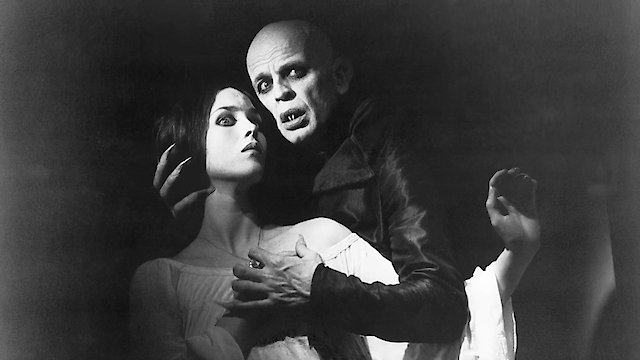
Nosferatu the Vampyre
Where to Watch Nosferatu the Vampyre

Nosferatu the Vampyre, a 1979 German film, breaks the conventional mold of horror - offering a psychological thriller laced with Gothic aesthetics and deeply eerie atmospherics. Directed by the established auteur, Werner Herzog, and starring Klaus Kinski, Isabelle Adjani, and Bruno Ganz, the movie is a potent blend of psychological exploration, macabre allure and visible horror. It serves as a vivid reinterpretation of F.W. Murnau's 1922 silent film adaptation, Nosferatu, while still remaining a unique testament to Herzog's atmospheric filmmaking ability.
In this chilling tale, Klaus Kinski embraces the role of Count Dracula, the central arch-nemesis, rendering a performance that merges sophistication, cruelty and melancholy in equal share. His interpretation of the character refrains from the traditional stereotyping of the fabled creature, instead, presenting Dracula as a lonely figure burdened by his immortal existence. Kinski's portrayal facilitates an unsettling sense of sympathy for the monster, presenting the audience with a radiant blend of horror and ambiguity.
The plot revolves around the tormented Jonathan Harker, played by Bruno Ganz. He's a naïve and dedicated real estate agent dispatched to the rugged landscapes of Transylvania to assist Count Dracula with a property purchase. As the narrative unfolds, Harker's journey into the labyrinthine castle unveils a chilling reality which progressively hints at the ominous presence of the vampiric entity. Amid Harker's tryst with the supernatural, Isabelle Adjani‘s Lucia Harker emerges as the essence of purity and innocence. Her portrayal of the tragic heroine, oblivious to the horrors her husband encounters, adds a heart-wrenching sentimentality to the narrative.
The film is a hauntingly beautiful celluloid canvas, its visual aesthetics as much a character as the iconic figures. Herzog's fondness for capturing vast landscapes and breathtaking visuals works wonderfully in creating a sense of unease and mystery. The remote, rugged terrains of Transylvania and the ominous, haunting ambiance of Dracula's castle provide a visual treat and greatly enrich the eerie atmosphere. Just as mesmerizing is the depiction of a plague-infested Wismar, exuding a palpable sense of desolation.
Instead of relying solely on the overt show of gore or sudden scares, Herzog leans heavily into a psychologically tense atmosphere. His Dracula, even more nightmarish in nonchalant speech and conduct, is a melancholic figure who woefully yearns for mortality. Here, horror is crafted more through bizarre images and a sense of impending ill-omen rather than visceral frights. This form of horror, steeped more in the terror of the unknown, is alternately menacing and hypnotically beautiful, evoking a dread that often lingers longer than any jump-scare could.
Another major strength of Nosferatu the Vampyre lies in the sound design and music. The soundtrack, by prolific German electronic music group Popol Vuh, reinforces the ambience with its eerie, lingering tones. It oscillates between mournful organ music and surreal tribal passages, intensifying the supernatural element of the film. Herzog's long-standing collaboration with Popol Vuh yields another sonically haunting cinema, further emphasizing its gothic horror mood.
The thematic depth in the film is far-reaching, exploring the fear of death, estrangement, existential dread and the tragic fate of its characters. Simultaneously, it probes deeply into vampire lore, delving into the nuances of the original fable and liberating the narrative from many of the genre's common clichés.
In conclusion, Nosferatu the Vampyre is much more than a typical horror film. It's a cinematic masterstroke painted in a gothic palette, a timeless celluloid poetry that transcends traditional horror paradigms. Werner Herzog's adept directorial vision, coupled with compelling performances from Klaus Kinski, Bruno Ganz, and Isabelle Adjani, takes viewers on an aesthetically haunting journey that continues to resonate in cinema history. Favoring psychological tension over direct fright, the film dares to humanise its monster, offering an emblematic narrative that dances on the fringes of horror and tragedy.
Nosferatu the Vampyre is a Drama, Horror movie released in 1979. It has a runtime of 107 min. Critics and viewers have rated it moderate reviews, with an IMDb score of 7.4. It also holds a MetaScore of 79.
How to Watch Nosferatu the Vampyre
Where can I stream Nosferatu the Vampyre movie online? Nosferatu the Vampyre is available to watch and stream, buy on demand, download at Prime Video, Prime Video, Philo, FuboTV, Crackle, Tubi TV, Apple TV Store, Amazon, Amazon, Kanopy, Sling, Fandango at Home. Some platforms allow you to rent Nosferatu the Vampyre for a limited time or purchase the movie for downloading.
